
Bergenia is a genus of ten species of flowering plants in the family Saxifragaceae, native to central Asia, from Afghanistan to China and the Himalayan region.
The common name umbrella plant can refer to several unrelated species:

Podophyllum is a genus of flowering plant in the family Berberidaceae, native from Afghanistan to China, and from southeast Canada to the central and eastern United States. The genus was first described by Carl Linnaeus in 1753.

Osmanthus is a genus of about 30 species of flowering plants in the family Oleaceae. Most of the species are native to eastern Asia ,and was originally found in the middle east of the Himalayas, with a few species from the Caucasus, New Caledonia, and Sumatra. Osmanthus has been known in China since ancient times with the earliest writings coming from the Warring States period; the book Sea and Mountain. South Mountain states: "Zhaoyao Mountain had a lot of Osmanthus".

Podophyllum peltatum is an herbaceous perennial plant in the family Berberidaceae. Its common names are mayapple, American mandrake, wild mandrake, and ground lemon. It is widespread across most of the eastern United States and southeastern Canada.

Podophyllotoxin (PPT) is the active ingredient in Podofilox, which is a medical cream that is used to treat genital warts and molluscum contagiosum. It is not recommended in HPV infections without external warts. It can be applied either by a healthcare provider or the person themselves.
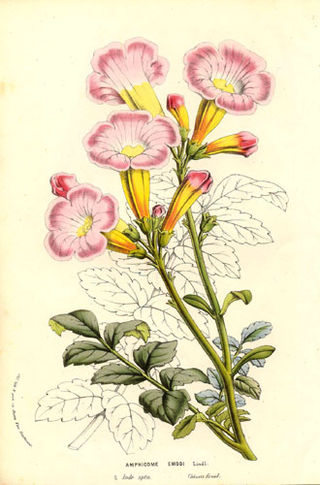
Incarvillea is a genus of about 16 species of flowering plants in the family Bignoniaceae, native to central and eastern Asia, with most of the species growing at high altitudes in the Himalaya and Tibet. The most familiar species is Incarvillea delavayi, a garden plant commonly known as hardy gloxinia or Chinese trumpet flower. Unlike most other members of Bignoniaceae, which are mainly tropical woody plants, species of Incarvillea are herbaceous perennial plants from temperate regions.

Epipodophyllotoxins are substances naturally occurring in the root of American Mayapple plant.

Euptoieta claudia, the variegated fritillary, is a North and South American butterfly in the family Nymphalidae. Even though the variegated fritillary has some very different characteristics from the Speyeria fritillaries, it is still closely related to them. Some of the differences are: variegated fritillaries have two or three broods per year vs. one per year in Speyeria; they are nomadic vs. sedentary; and they use a wide range of host plants vs. just violets. And because of their use of passionflowers as a host plant, variegated fritillaries also have taxonomic links to the heliconians. Their flight is low and swift, but even when resting or nectaring, this species is extremely difficult to approach, and, because of this, its genus name was taken from the Greek word euptoietos meaning "easily scared".

Paeonia delavayi is a low woody shrub belonging to the peonies, that is endemic to China. The vernacular name in China is 滇牡丹. In English it is called Delavay's tree peony, Delavay peony, Dian peony, and dian mu dan. It mostly has red brown to yellow, nodding flowers from mid May to mid June. The light green, delicate looking deciduous leaves consist of many segments, and are alternately arranged on new growth.
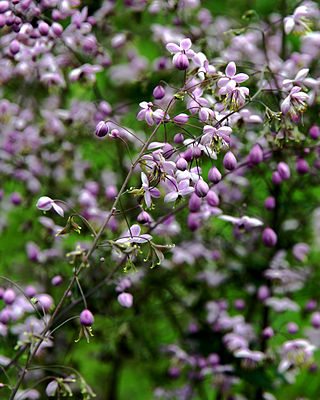
Thalictrum delavayi, Chinese meadow-rue, is a species of flowering plant in the family Ranunculaceae native to China. Growing to 1.2 m (4 ft) tall by 60 cm (24 in) wide, it is a herbaceous perennial with leaves divided into many small leaflets, and panicles of lilac flowers with green or white stamens in summer.

Osmanthus delavayi is a species of flowering plant in the olive family Oleaceae. It is an evergreen shrub native to the Guizhou, Sichuan and Yunnan regions of southern China, and widely cultivated as an ornamental in temperate and subtropical zones elsewhere.
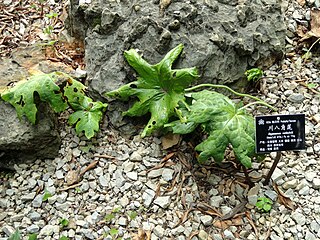
Dysosma is a group of herbaceous perennials in the Berberidaceae or barberry family described as a genus in 1928. It is native to China and Indochina.

Iris delavayi is a species of flowering plant in the subgenus Limniris and in the series Sibiricae of the family Iridaceae. This rhizomatous herbaceous perennial comes from various provinces in China. It has grey-green leaves, long hollow stem, and 2 flowers in various blue shades. From dark violet, dark purple, purple-blue, dark blue to light purple. It is cultivated as an ornamental plant in temperate regions.

Syngonium podophyllum is a species of aroid that is a popular houseplant. Common names include: arrowhead plant, arrowhead vine, arrowhead philodendron, goosefoot, nephthytis, African evergreen, and American evergreen. The species is native to a wide region of Latin America from Mexico through Bolivia, and naturalized in the West Indies, Florida, Texas, Hawaii, and other places.
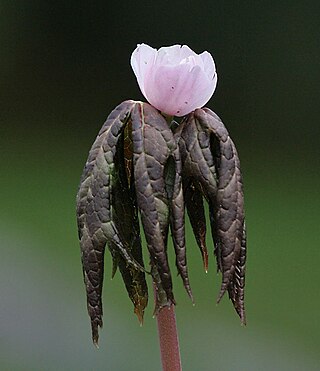
Sinopodophyllum is an herbaceous perennial plant in the family Berberidaceae, described as a genus in 1979. It includes only one known species, Sinopodophyllum hexandrum, native to Afghanistan, Bhutan, northern India, Kashmir, Nepal, Pakistan, and western China. Common names include Himalayan may apple and Indian may apple.

Lonicera similis is a species of flowering plant in the family Caprifoliaceae, native to Western China. This honeysuckle is known in cultivation by the variety delavayi which is reported by some authorities to be synonymous with L. similis itself. It is a large, twining, semi-evergreen shrub growing to 8 m (26 ft) tall by 1.5 m (4.9 ft) broad, with a profusion of fragrant tubular flowers opening white and ageing to yellow, in late summer and autumn. The flowers are followed by black berries. The Latin specific epithet similis means “similar to”. It is similar in appearance to L. japonica, but larger and more robust. The name delavayi honours the French missionary and botanist Père Jean Marie Delavay (1834-1895).

Dysosma versipellis is a species of flowering plant in the barberry family Berberidaceae, native to China. It is still widely referenced under Podophyllum versipelle and there is some debate as to its correct taxonomic status. Though it has quite a broad but sparse distribution in the damp, shady forests of south and west China, it has been designated as “Vulnerable” by the IUCN. A compact herbaceous perennial growing to 50 cm (20 in) tall and broad, it grows from underground rhizomes, with umbrella-shaped leaves and dark red, tubular, pendent flowers in spring.

Podophyllum pleianthum, the many-flowered Chinese mayapple, is a species of flowering plant in the genus Podophyllum, native to south-central and southeast China, including Taiwan. Shade tolerant, and deer resistant due to its toxicity, it has gained the Royal Horticultural Society's Award of Garden Merit.
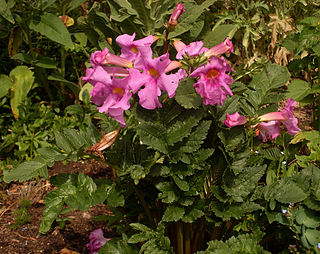
Incarvillea delavayi, the so‑called hardy gloxinia or flowering fern, is a species of flowering plant in the family Bignoniaceae, native to western Sichuan and northwest Yunnan provinces of China. The true Gloxinia are members of the Gesneriaceae, while true ferns are flowerless plants which reproduce through spores.

















